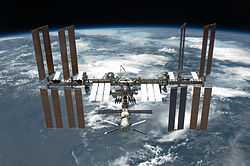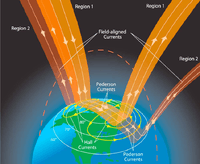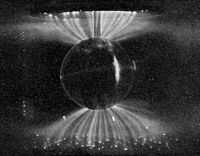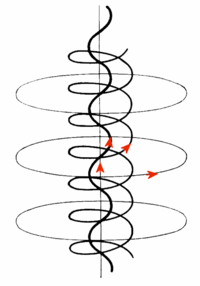Plasmas/Ions
< PlasmasAn ion is an atom or molecule with a net electric charge due to the loss or gain of one or more electrons.
Theory of ions
Def. "[a]n atom or group of atoms bearing an electrical charge such as the sodium and chlorine atoms in a salt solution"[1] is called an ion.
Cosmic rays
“About 89% of cosmic rays are simple protons or hydrogen nuclei, 10% are helium nuclei of alpha particles, and 1% are the nuclei of heavier elements. ... Solitary electrons ... constitute much of the remaining 1%.”[2]
Venus
"In 1967, Venera-4 found the Venusian magnetic field is much weaker than that of Earth. This magnetic field is induced by an interaction between the ionosphere and the solar wind,[3][4] ... Venus's small induced magnetosphere provides negligible protection to the atmosphere against cosmic radiation. This radiation may result in cloud-to-cloud lightning discharges.[5]"[6]
"The weak magnetosphere around Venus means the solar wind is interacting directly with the outer atmosphere of the planet. Here, ions of hydrogen and oxygen are being created by the dissociation of neutral molecules from ultraviolet radiation. The solar wind then supplies energy that gives some of these ions sufficient velocity to escape the planet's gravity field. This erosion process results in a steady loss of low-mass hydrogen, helium, and oxygen ions, while higher-mass molecules, such as carbon dioxide, are more likely to be retained."[6]
Earth

Between the surface and various altitudes there is an electric field. It changes with altitude from about 150 volts per meter to lower values at higher altitude. In fair weather, it is relatively constant, in turbulent weather it is accompanied by ions. At greater altitude these chemical species continue to increase in concentration.
The air pressure is lowering as is the ambient temperature.
Upon reaching the top of the mesosphere, the temperature starts to rise, but air pressure continues to fall. This is the beginning of the ionosphere, a region dominated by chemical ions. Many of them are the same chemicals such as nitrogen and oxygen in the atmosphere below, but an ever increasing number are hydrogen ions (protons) and helium ions. These can be detected by an ion spectrometer. The process of ionization removes one or more electrons from a neutral atom to yield a variety of ions depending on the chemical element species and incidence of sufficient energy to remove the electrons.
From the ground below, or with spectrometers on platforms at higher altitude, including satellites, ion species and concentrations are measured. Into the exosphere or outer space, temperature rises from around 1,500°C (centigrade) to upwards of 100,000 K (kelvin).
Birkeland currents


The schematic at right describes the Birkeland or field-aligned currents and the ionospheric current systems they connect to.[8]
"A Birkeland current is a set of currents which flow along geomagnetic field lines connecting the Earth’s magnetosphere to the Earth's high latitude ionosphere. Lately, the term Birkeland currents has been expanded by some authors to include magnetic field aligned currents in space plasmas in general. In the Earth’s magnetosphere, the currents are driven by the solar wind and interplanetary magnetic field and by bulk motions of plasma through the magnetosphere (convection which is indirectly driven by the interplanetary environment). The strength of the Birkeland currents changes with activity in the magnetosphere (e.g. during substorms). Small scale variations in the upward current sheets (downward flowing electrons) accelerate magnetospheric electrons which, when they reach the upper atmosphere, create the Aurora Borealis and Australis. In the high latitude ionosphere (or auroral zones), the Birkeland currents close through the region of the auroral electrojet, which flows perpendicular to the local magnetic field in the ionosphere. The Birkeland currents occur in two pairs of field-aligned current sheets. One pair extends from noon through the dusk sector to the midnight sector. The other pair extends from noon through the dawn sector to the midnight sector. The sheet on the high latitude side of the auroral zone is referred to as the Region 1 current sheet and the sheet on the low latitude side is referred to as the Region 2 current sheet."[9]
"A reason why Birkeland currents are particularly interesting is that, in the plasma forced to carry them, they cause a number of plasma physical processes to occur (waves, instabilities, fine structure formation). These in turn lead to consequences such as acceleration of charged particles, both positive and negative, and element separation (such as preferential ejection of oxygen ions). Both of these classes of phenomena should have a general astrophysical interest far beyond that of understanding the space environment of our own Earth."[10]
"Auroral Birkeland currents carry about 100,000 amperes during quiet times[11] and more than 1 million amperes during geomagnetically disturbed times.[12] Birkeland had estimated currents "at heights of several hundred kilometres, and strengths of up to a million amperes" in 1908.[13] The ionospheric currents which connect the field-aligned currents heat up the upper atmosphere due to the finite conductivity of the ionosphere. The heat (also known as Joule heat) is transferred from the ionospheric plasma to the gas of the upper atmosphere which rises and increases drag on low-altitude satellites."[9]
"Birkeland currents can also be created in the laboratory with multi-terawatt pulsed power generators. The resulting cross-section pattern indicates a hollow beam of electrons in the form of a circle of vortices, a formation called the diocotron instability[14] (similar to, but different from, the Kelvin-Helmholtz instability), that subsequently leads to filamentation. Such vortices can be seen in aurora as "auroral curls".[15]"[9]
"Birkeland currents are also one of a class of plasma phenomena called a z-pinch, so named because the azimuthal magnetic fields produced by the current pinches the current into a filamentary cable. This can also twist, producing a helical pinch that spirals like a twisted or braided rope, and this most closely corresponds to a Birkeland current. Pairs of parallel Birkeland currents will also interact due to Ampère's force law: parallel Birkeland currents moving in the same direction will attract each other with an electromagnetic force inversely proportional to their distance apart whilst parallel Birkeland currents moving in opposite directions will repel each other. There is also a short-range circular component to the force between two Birkeland currents that is opposite to the longer-range parallel forces.[16]"[9]
"Electrons moving along a Birkeland current may be accelerated by a plasma double layer. If the resulting electrons approach relativistic velocities (i.e. if they approach the speed of light) they may subsequently produce a Bennett pinch, which in a magnetic field causes the electrons to spiral and emit synchrotron radiation that may include radio, optical (i.e. visible light), x-rays, and gamma rays."[9]
"[T]he currents there are imagined as having come into existence mainly as a secondary effect of the electric corpuscles from the sun drawn in out of space, and thus far come under the second of the possibilities mentioned above". And p. 105, "Fig. 50a represents those in which the current-directions at the storm-centre are directed westwards, and 50b those in which the currents move eastwards"[13].
"[C]urrents there [in the aurora] are imagined as having come into existence mainly as a secondary effect of the electric corpuscles from the sun drawn in out of space,"[13]
Interplanetary medium
"[F]luxes of ions should be measurable from a detector in a 100 km lunar orbit."[17]
Electrohydrodynamics
“Electrohydrodynamics (EHD), also known as electro-fluid-dynamics (EFD) or electrokinetics, is the study of the dynamics of electrically charged fluids.[18] It is the study of the motions of ionised particles or molecules and their interactions with electric fields and the surrounding fluid. The term may be considered to be synonymous with the rather elaborate electrostrictive hydrodynamics. EHD covers the following types of particle and fluid transport mechanisms: Electrophoresis, electrokinesis, dielectrophoresis, electro-osmosis, and electrorotation. In general, the phenomena relate to the direct conversion of electrical energy into kinetic energy, and vice versa."[19]
"In the first instance, shaped electrostatic fields create hydrostatic pressure (or motion) in dielectric media. When such media are fluids, a flow is produced. If the dielectric is a vacuum or a solid, no flow is produced. Such flow can be directed against the electrodes, generally to move the electrodes. In such case, the moving structure acts as an electric motor.”[19]
Waves
"Waves in plasmas are an interconnected set of particles and fields which propagates in a periodically repeating fashion. A plasma is a quasineutral, electrically conductive fluid. In the simplest case, it is composed of electrons and a single species of positive ions, but it may also contain multiple ion species including negative ions as well as neutral particles. Due to its electrical conductivity, a plasma couples to electric and magnetic fields. This complex of particles and fields supports a wide variety of waves."[20]
"Waves in plasmas can be classified as electromagnetic or electrostatic according to whether or not there is an oscillating magnetic field. Applying Faraday's law of induction to plane waves, we find  , implying that an electrostatic wave must be purely longitudinal. An electromagnetic wave, in contrast, must have a transverse component, but may also be partially longitudinal."[20]
, implying that an electrostatic wave must be purely longitudinal. An electromagnetic wave, in contrast, must have a transverse component, but may also be partially longitudinal."[20]
"Waves can be further classified by the oscillating species. In most plasmas of interest, the electron temperature is comparable to or larger than the ion temperature. This fact, coupled with the much smaller mass of the electron, implies that the electrons are much faster than the ions. An electron mode depends on the mass of the electrons, but the ions may be assumed to be infinitely massive, i.e. stationary. An ion mode depends on the ion mass, but the electrons are assumed to be massless and to redistribute themselves instantaneously according to the Boltzmann relation. Only rarely, e.g. in the lower hybrid oscillation, will a mode depend on both the electron and the ion mass."[20]
"The various modes can also be classified according to whether they propagate in an unmagnetized plasma or parallel, perpendicular, or oblique to the stationary magnetic field. Finally, for perpendicular electromagnetic electron waves, the perturbed electric field can be parallel or perpendicular to the stationary magnetic field."[20]
| EM character | oscillating species | conditions | dispersion relation | name |
|---|---|---|---|---|
| electrostatic | electrons |  |  | plasma oscillation (or Langmuir wave) |
 |  | upper hybrid oscillation | ||
| ions |  |  | ion acoustic wave | |
 (nearly) (nearly) |  | electrostatic ion cyclotron wave | ||
 (exactly) (exactly) | ![\omega^2=[(\Omega_c\omega_c)^{-1}+\omega_i^{-2}]^{-1}](../I/m/6f31c7faf14ac9eba6788f9e038fdc3a.png) | lower hybrid oscillation | ||
| electromagnetic | electrons |  |  | light wave |
 |  | O wave | ||
 |  | X wave | ||
 (right circ. pol.) (right circ. pol.) |  | R wave (whistler mode) | ||
 (left circ. pol.) (left circ. pol.) |  | L wave | ||
| ions |  | none | ||
 |  | Alfvén wave | ||
 |  | magnetosonic wave |
 - wave frequency,
- wave frequency,
 - wave number,
- wave number,
 - speed of light,
- speed of light,
 - plasma frequency,
- plasma frequency,
 - ion plasma frequency,
- ion plasma frequency,
 - electron gyrofrequency,
- electron gyrofrequency,
 - proton gyrofrequency,
- proton gyrofrequency,
 - upper hybrid frequency,
- upper hybrid frequency,
 - plasma "sound" speed,
- plasma "sound" speed,
 - plasma Alfven speed
- plasma Alfven speed
Research
Hypothesis:
- Ions are as easy to create in a polar liquid like water as they are in the interplanetary medium.
Control groups

The findings demonstrate a statistically systematic change from the status quo or the control group.
“In the design of experiments, treatments [or special properties or characteristics] are applied to [or observed in] experimental units in the treatment group(s).[21] In comparative experiments, members of the complementary group, the control group, receive either no treatment or a standard treatment.[22]"[23]
Proof of concept
Def. a “short and/or incomplete realization of a certain method or idea to demonstrate its feasibility"[24] is called a proof of concept.
Def. evidence that demonstrates that a concept is possible is called proof of concept.
The proof-of-concept structure consists of
- background,
- procedures,
- findings, and
- interpretation.[25]
See also
References
- ↑ Trunkie (14 September 2004). "ion, In: Wiktionary". San Francisco, California: Wikimedia Foundation, Inc. Retrieved 2014-12-08.
- ↑ "Cosmic ray, In: Wikipedia". San Francisco, California: Wikimedia Foundation, Inc. August 17, 2012. Retrieved 2012-08-17.
- ↑ Dolginov, Nature of the Magnetic Field in the Neighborhood of Venus, COsmic Research, 1969
- ↑ Kivelson G. M., Russell, C. T. (1995). Introduction to Space Physics. Cambridge University Press. ISBN 0-521-45714-9.
- ↑ Upadhyay, H. O.; Singh, R. N. (April 1995). "Cosmic ray Ionization of Lower Venus Atmosphere". Advances in Space Research 15 (4): 99–108. doi:10.1016/0273-1177(94)00070-H.
- 1 2 "Venus, In: Wikipedia". San Francisco, California: Wikimedia Foundation, Inc. September 27, 2012. Retrieved 2012-10-04.
- ↑ Hannes Alfvén (1976). Evolution of the Solar System. Washington. D.C., USA: Scientific and Technical Information Office, National Aeronautics and Space Administration. http://history.nasa.gov/SP-345/sp345.htm.
- ↑ G. Le, J. A. Slavin, and R. J. Strangeway (2010). "Space Technology 5 observations of the imbalance of regions 1 and 2 field-aligned currents and its implication to the cross-polar cap Pedersen currents". Journal of Geophys. Research 115 (A07202). doi:10.1029/2009JA014979.
- 1 2 3 4 5 "Birkeland current, In: Wikipedia". San Francisco, California: Wikimedia Foundation, Inc. October 15, 2012. Retrieved 2012-11-17.
- ↑ Carl-Gunne Fälthammar (December 1986). "Magnetosphere-Ionosphere Interactions. Near Earth Manifestations of the Plasma Universe". IEEE Transactions on Plasma Science PS-14 (6): 616–28. doi:10.1109/TPS.1986.4316613.
- ↑ Akira Suzuki, Naoshi Fukushima (1998). "Space current around the earth obtained with Ampère’s law applied to the MAGSAT orbit and data". Earth Planets Space 50 (1): 43–56. http://www.terrapub.co.jp/journals/EPS/pdf/5001/50010043.pdf.
- ↑ B. J. Anderson, J. B. Gary, T. A. Potemra, R. A. Frahm, J. R. Sharber, and J. D. Winningham (1998). "UARS observations of Birkeland currents and Joule heating rates for the November 4, 1993, storm". J. Geophys. Research 103 (A11): 26323–35. doi:10.1029/98JA01236.
- 1 2 3 Birkeland, Kristian (1908 (section 1), 1913 (section 2)). The Norwegian Aurora Polaris Expedition 1902-1903. New York and Christiania (now Oslo): H. Aschehoug & Co. http://www.archive.org/details/norwegianaurorap01chririch. out-of-print, full text online
- ↑ Plasma phenomena - instabilities
- ↑ Pseudo-color, white-light images of curl formations in auroral arcs
- ↑ Electromagnetic Forces
- ↑ Theodore E. Madey, Robert E. Johnson, Thom M. Orlando (March 2002). "Far-out surface science: radiation-induced surface processes in the solar system". Surface Science 500 (1-3): 838-58. doi:10.1016/S0039-6028(01)01556-4. http://www.sciencedirect.com/science/article/pii/S0039602801015564. Retrieved 2012-02-09.
- ↑ Castellanos, A. (1998). Electrohydrodynamics.
- 1 2 "Electrohydrodynamics, In: Wikipedia". San Francisco, California: Wikimedia Foundation, Inc. May 11, 2012. Retrieved 2012-11-14.
- 1 2 3 4 5 "Waves in plasmas, In: Wikipedia". San Francisco, California: Wikimedia Foundation, Inc. November 8, 2012. Retrieved 2012-11-18.
- ↑ Klaus Hinkelmann, Oscar Kempthorne (2008). Design and Analysis of Experiments, Volume I: Introduction to Experimental Design (2nd ed.). Wiley. ISBN 978-0-471-72756-9. http://books.google.com/?id=T3wWj2kVYZgC&printsec=frontcover.
- ↑ R. A. Bailey (2008). Design of comparative experiments. Cambridge University Press. ISBN 978-0-521-68357-9. http://www.cambridge.org/uk/catalogue/catalogue.asp?isbn=9780521683579.
- ↑ "Treatment and control groups, In: Wikipedia". San Francisco, California: Wikimedia Foundation, Inc. May 18, 2012. Retrieved 2012-05-31.
- ↑ "proof of concept, In: Wiktionary". San Francisco, California: Wikimedia Foundation, Inc. November 10, 2012. Retrieved 2013-01-13.
- ↑ Ginger Lehrman and Ian B Hogue, Sarah Palmer, Cheryl Jennings, Celsa A Spina, Ann Wiegand, Alan L Landay, Robert W Coombs, Douglas D Richman, John W Mellors, John M Coffin, Ronald J Bosch, David M Margolis (August 13, 2005). "Depletion of latent HIV-1 infection in vivo: a proof-of-concept study". Lancet 366 (9485): 549-55. doi:10.1016/S0140-6736(05)67098-5. http://www.ncbi.nlm.nih.gov/pmc/articles/PMC1894952/. Retrieved 2012-05-09.
External links
| ||||||||||||||||||||||||||||||||||||||
![]() This is a research project at http://en.wikiversity.org
This is a research project at http://en.wikiversity.org
| |
Educational level: this is a research resource. |
| |
Resource type: this resource is an article. |
| |
Resource type: this resource contains a lecture or lecture notes. |
| |
Subject classification: this is an astronomy resource. |
| |
Subject classification: this is a physics resource . |
